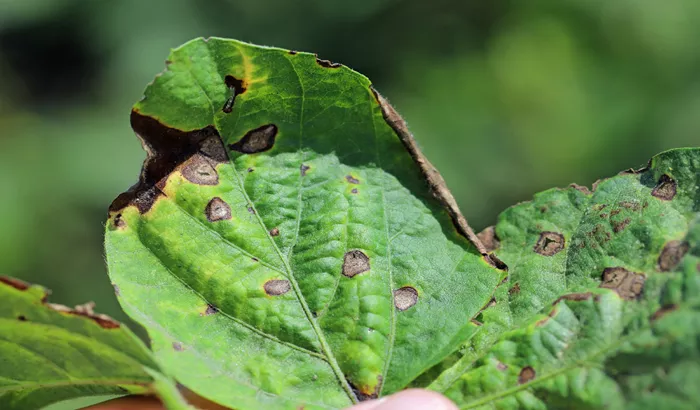Fungal diseases are common threats to plants, often causing significant damage to crops, ornamental plants, and trees. Fungi can affect plants in various ways, from wilting and discoloration to even complete plant death. Understanding these fungal infections and their symptoms can help gardeners take the right actions to prevent or treat them. In this article, we will explore 5 common plant diseases caused by fungi, providing insights into their causes, symptoms, and treatment options. Whether you’re a beginner or a seasoned gardener, knowing how to identify and manage fungal infections is essential for maintaining a healthy garden.
What Are 5 Diseases Caused By Fungi In Plants?
1. Powdery Mildew
Powdery mildew is one of the most well-known fungal diseases that affect a wide variety of plants, including roses, cucumbers, and grapes. This disease is caused by several different fungal species, but they all share similar characteristics. Powdery mildew presents itself as white, powdery spots on leaves, stems, and buds. If left untreated, it can cause leaves to yellow, curl, and eventually drop off.
Cause and Symptoms: The fungus thrives in warm, dry conditions, often appearing in the early spring or late summer. Initially, the spots are small and white, but as the disease progresses, they can cover entire leaves and stems. The fungus weakens the plant, making it more susceptible to other pests and diseases.
Treatment: Powdery mildew can be controlled with fungicides, neem oil, or homemade remedies like baking soda solutions. It’s also crucial to space plants to improve airflow and reduce humidity.
2. Downy Mildew
Downy mildew is another fungal disease that affects various plants, such as lettuce, basil, and cucumbers. Unlike powdery mildew, downy mildew appears as yellow to white patches on the upper side of leaves, with fuzzy purple or gray growths visible on the underside.
Cause and Symptoms: Downy mildew is caused by a group of fungi that thrive in cool, damp environments. The disease spreads quickly, causing leaves to die prematurely. Infected plants often show stunted growth, and the leaves may become deformed or drop off.
Treatment: To treat downy mildew, gardeners should remove infected leaves and apply appropriate fungicides. Ensuring proper spacing and watering practices can also help reduce the risk of infection.
3. Rust Diseases
Rust is a fungal disease that primarily affects the leaves of plants. It can appear as orange, yellow, or brown pustules, which can be seen on the upper and lower surfaces of leaves. Rust can affect a wide range of plants, including beans, roses, and ornamental flowers.
Cause and Symptoms: Rust fungi require specific environmental conditions to thrive, including high humidity and moderate temperatures. The disease progresses by producing spores that spread to other plants. As the disease advances, leaves may become distorted, wither, and fall off, leading to reduced photosynthesis and weakened plants.
Treatment: Rust can be controlled by removing infected leaves and applying fungicides. Additionally, proper spacing, regular pruning, and selecting resistant plant varieties can help prevent future outbreaks.
4. Fusarium Wilt
Fusarium wilt is a fungal infection that causes plants to wilt and die. It is caused by the fungus Fusarium oxysporum, which infects the vascular system of the plant. Common plants affected by Fusarium wilt include tomatoes, peppers, and melons.
Cause and Symptoms: Fusarium fungi infect the roots and spread through the plant’s vascular tissue, blocking the flow of water and nutrients. Symptoms include yellowing leaves, wilting, and stunted growth. In severe cases, the plant may die entirely.
Treatment: Fusarium wilt is difficult to treat once a plant is infected, as the fungus remains in the soil for years. Preventive measures include rotating crops, using disease-resistant varieties, and practicing good soil management.
5. Anthracnose
Anthracnose is a fungal disease that affects a variety of plants, including trees, vegetables, and flowers. It causes dark, sunken lesions on leaves, stems, and fruits, often leading to premature leaf drop and plant death.
Cause and Symptoms: The disease thrives in warm, wet conditions and is typically spread by rain or wind. Infected plants show symptoms such as blackened spots with a yellow halo on leaves and lesions on fruits. The disease can significantly impact plant growth and yield.
Treatment: Treatment for anthracnose includes removing infected plant parts and applying fungicides. Proper plant spacing, improving drainage, and avoiding overhead watering can also help reduce the risk of infection.
Closing Remarks
Fungal diseases are a significant concern for gardeners and can damage plants quickly if not addressed. Identifying these diseases early and taking action is key to protecting your garden. By following preventive measures, such as improving plant spacing, ensuring proper watering, and applying appropriate fungicides, gardeners can minimize the risk of fungal infections and maintain a healthy garden. Stay vigilant and keep an eye out for the symptoms of common fungal diseases, as early intervention is the best way to ensure your plants thrive.


